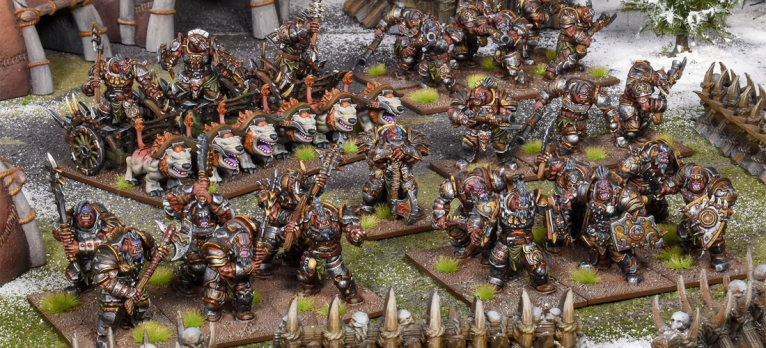Category:Ogres
Ogres are mercenaries, happy to sell their skills to the highest bidder. Huge, powerful creatures that might almost have been purpose bred for war, few races can match them for sheer belligerent power and endurance, and many a war has been won by the side that hired the most.
About
Ogres are in demand the world over as soldiers, and mercenary bands can be found across the whole of Pannithor. Wealthy patrons can obtain the services of entire hordes of Ogres, banded together as an army under the leadership of a particularly charismatic (or just violent) Captain. Such a gathering of might is enough to strike fear into the hearts of their enemies, even before they begin to charge
Warfare
The Ogres of Pannithor are a tough breed, hailing from the Mammoth Steppe in the north. This realm of tough grassland and icy plateaus is far from hospitable, and a hard life awaits any humans foolhardy enough to settle there. The Ogres are proud to call this land home, for it has forged their destiny; it is surely no coincidence that the warriors of the Steppe are among the most highly-regarded fighters in Pannithor.
Culture
With no written word, much of Ogre history has vanished into the darkness of the past. Modern scholars fret about, trying to piece together the origin of the Ogres, much to the amusement of the Ogres themselves. This dismissal of intellectual pursuits coupled with their employment as mercenaries has given rise to the stereotype that Ogres are nothing more than uncultured brutes in search of gold.
Nothing could be further from the truth. The Ogre language is perhaps the most complicated in the world, with fourteen classes of female pronoun, each dependent on context and the speaker’s relationship to the subject. Speaking of an Ogre’s mother is almost never a good idea unless one has spent at least a decade studying the language. This complex language suits the Ogres for they are at heart a people of story tellers, not stories of deeds long past, but events the teller actually experienced, embellished in the telling. An Ogre proves their wealth through the stories they have collected, not through gold amassed.
Ogre society is more complex than outsiders often realise, governed by a strict hierarchy based on martial skill and respect, far more sophisticated than the savagery of the Orc. For a nomadic people such as Ogres, skill at the hunt is just as important as skill in battle. Hunting requires not only strength of body and feats of arms, but cunning, intelligence and fieldcraft. Hunters are greatly respected within their tribes, possessing a variety of finely-honed skills passed from one generation to the next. These skills also transfer well on to the battlefield, allowing them to set traps, ambush the foe, and target the monstrous mounts and minions of their enemies, or equally drive their own bestial charges before them into the fray.
A race of individuals, Ogres have never been able to understand why the other races pass one person’s belongings to their children when they die. For Ogres, such an act wrongs both the deceased and the children, since the children will not have to opportunity to earn what they inherited. To give an Ogre a gift is perhaps the greatest insult possible, one which almost always ends in someone’s death. From childhood, an Ogre struggles to survive against the wild beasts and frigid landscape of the frozen north.
Those few that survive to adulthood possess incredible skill on top of their sheer physical size and strength. They grow up listening to the stories their family members tell of their time fighting as mercenaries. They hear of the great mountains of Abercarr and the expanding desert of the Eastern Reaches. For an Ogre, no honour comes from knowing his father visited these places. They must travel the world, fight its horrors, and return with great riches to prove their own worth, to make their own stories.
Red Goblins
Many goblins are attracted to the wealth and power of ogre mercenary armies. They become camp followers and attend to all of the most menial of tasks in an ogre encampment. Occasionally, hordes of these creatures are marched to war, their natural stealth and strength in numbers complementing the ogres well.
Goblins are regularly pressed into service by ogre sergeants, who mark them with red clothing or warpaint as a sign of ownership. The so-called ‘red goblins’ wear this colour with pride and an uncharacteristic loyalty to their masters.
While the small creatures are still too cowardly for combat, the fear of their hulking masters is greater than their fear of the enemy. Red goblin Biggits lead their rabble into battle on behalf of their ogre masters. They think they are in charge, but in reality, they wield no more power than the other goblins.
The Thing
Thus, every year there is the Thing. They call this gathering the Thing for there are no other things in the Ogre calendar, no festivals or holidays. At the Thing, young Ogres sign on to a veteran captain, who persuades them of his worth through reciting his own adventures in the south. Every nation in the world will pay handsomely for the service of an Ogre band, so an Ogre will have crossed Pannithor twice over by the time they decide to return home.
Upon returning to the warring tribes of their frozen land, they will find a mate and sire a few little ones. Those children that survive to understand speech will sit at their father’s feet, eyes wide, listening intently as he explains how he fought in the south and saw things they could not believe. And so a new generation will grow up, raise their swords, and charge across the world, eager to carve out their own stories.
Mercenary Companies
Army List

Retired Units
Pages in category "Ogres"
The following 26 pages are in this category, out of 26 total.

